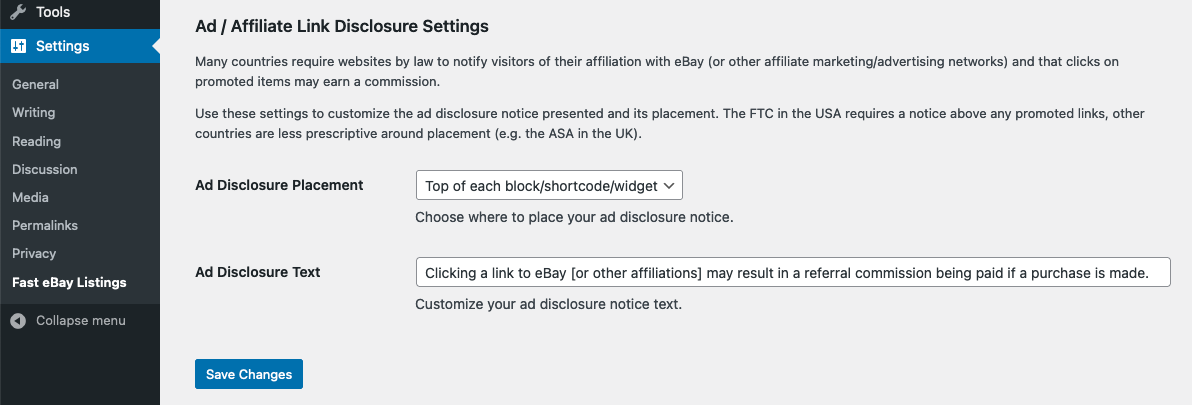 A lot has changed in the world of affiliate marketing over the years. Way back, it had a bit of a Wild West feel with few rules, but these days things are a lot more regulated. As an affiliate marketer trying to earn an income from the eBay Partner Network (EPN) or other ad and affiliate networks, you need to adhere to regulations that apply to your business. Failure to do so could land you in trouble, from having your EPN account terminated to a Google Manual action blacklisting your website.
A lot has changed in the world of affiliate marketing over the years. Way back, it had a bit of a Wild West feel with few rules, but these days things are a lot more regulated. As an affiliate marketer trying to earn an income from the eBay Partner Network (EPN) or other ad and affiliate networks, you need to adhere to regulations that apply to your business. Failure to do so could land you in trouble, from having your EPN account terminated to a Google Manual action blacklisting your website.
Much of the regulation impacting affiliate marketing is designed to provide full transparency to visitors of your site so they are fully aware that clicking links on your site may earn you a commission and thus why they are placed before them on the page.
So What Should You Do?
Don’t worry, only minor additions are needed on your site to adhere to recent regulations. In a nutshell, you need to make sure ads and affiliate links are clear to visitors. The FTC in the US states ‘the guiding principle is that it has to be clear and conspicuous.’. The ASA in the UK states ads ‘must be obviously identifiable as such’.
You can satisfy these rulings by simply adding a line of text to describe links as affiliations.
The FTC in the US is more prescriptive in its guidelines than other countries, but its requirements more than satisfy the requirements of many other countries. As such you can easily make your site compliant for many jurisdictions. The EPN Network Agreement stipulates you need to adhere to the FTC’s guidelines in all regions served by eBay.
Why Should You Even Bother to Display Affiliate Disclosure?
I can totally sympathise with you here, it does feel like yet another redundant and annoying notice visitors will blindly zone out, like the cookie popups. It is more clutter on your page, and worse, what if it even discourages visitors from clicking your affiliate links?!
Regardless of your thoughts here, it is now law in many countries and failure to comply could potentially lead to penalties from your local advertising authority.
Secondly, the eBay Partner Network (and many other affiliate networks) dictate you should follow these rules as part of their terms. Thus, failure to comply puts you in breach of these terms and could jeopardise your affiliation with eBay and other networks. You don’t want to be kicked from these, as then you’ll completely lose your revenue stream!
Thirdly, in some markets, failure to disclose your affiliate relationship could legally imply that you as a partner have “adopted” the content and are therefore liable for it. So these disclosure measures also protect your business.
How Fast eBay Listings Can Help You
To help you adhere to these ad disclosure guidelines, Fast eBay Listings has features to automatically display a suitable notice on your webpage for you.
You can tailor this feature in the ‘eBay Partner Network’ section of the plugin settings, where you can customise how the disclosure notice will be displayed on your website.

You can tailor where the ad disclosure notice should be shown:
- At the top of each page
- At the top of each Fast eBay Listings block, shortcode or widget
- Below each Fast eBay Listings block, shortcode or widget
A default suggested text is provided, but you can fully customise the exact disclosure text that is shown to meet your exact needs or site language (Premium Subscribers only).
What Settings Should I Use?
Which ad disclosure setting you use will depend on many things. Whether you are based in the USA and subject to the FTC regulations, or whether pages on your site have links to multiple ad/affiliate networks or multiple uses of the Fast eBay Listings plugin.
Ask yourself these questions to choose the best setting for your site:
- By default, place your notice at the top of each Fast eBay Listings usage, to meet the more prescriptive FTC guidelines and adhere to the EPN Network Agreement that echoes the same requirements.
- Do your pages have links to multiple ad/affiliate networks, or use multiple instances of the Fast eBay Listings plugin (e.g. multiple eBay searches on one page)?
- If so, then choose a placement at the top of the page, to cover all ads and affiliate links with a single notice to avoid repetition.
What if I’m not using the eBay Partner Network?
If you are using Fast eBay Listings to display your Store Inventory on your website and are not a member of the eBay Partner Network (EPN), you may be wondering why you need to display an ad disclosure notice. When using the free version of Fast eBay Listings, links will be monetised via the EPN to earn the developer commission to cover the support and maintenance of this plugin, thus an ad disclosure notice is mandatory in the free version.
However, subscribers of the premium version of Fast eBay Listings will have the option to remove the ad disclosure notice. This option is only recommended when not monetising links via the EPN (and the EPN Campaign ID field in the settings is left blank).